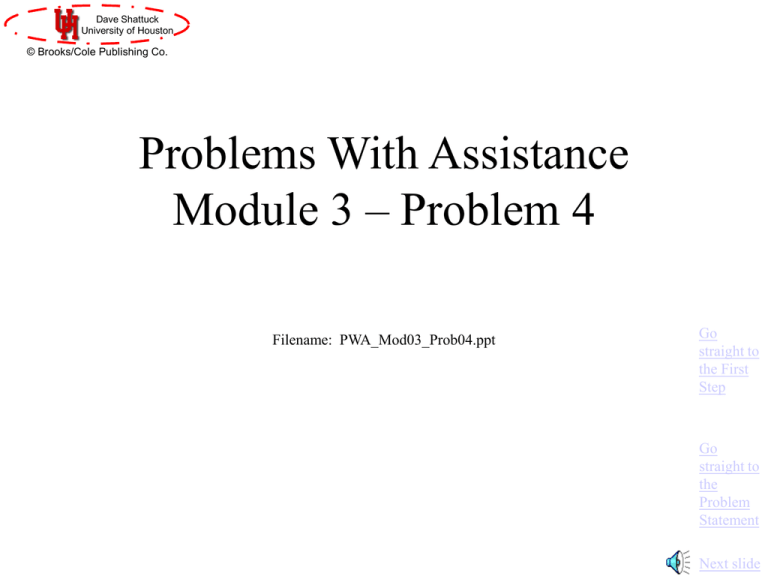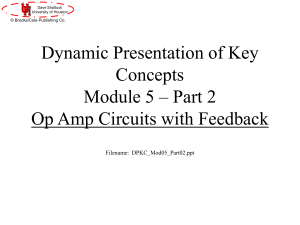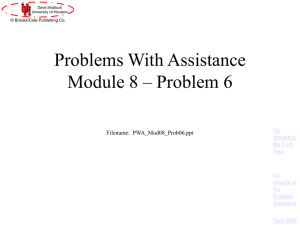PWA_Mod03_Prob04_v02
advertisement

Dave Shattuck University of Houston © Brooks/Cole Publishing Co. Problems With Assistance Module 3 – Problem 4 Filename: PWA_Mod03_Prob04.ppt Go straight to the First Step Go straight to the Problem Statement Next slide Dave Shattuck University of Houston © Brooks/Cole Publishing Co. Overview of this Problem In this problem, we will use the following concepts: • Kirchhoff’s Voltage Law • Kirchhoff’s Current Law • Ohm’s Law • The Mesh-Current Method Go straight to the First Step Go straight to the Problem Statement Next slide Dave Shattuck University of Houston © Brooks/Cole Publishing Co. Textbook Coverage This material is covered in your textbook in the following sections: • Circuits by Carlson: Sections 4.2 & 4.3 • Electric Circuits 6th Ed. by Nilsson and Riedel: Sections 4.1, & 4.5 through 4.7 • Basic Engineering Circuit Analysis 6th Ed. by Irwin and Wu: Section 3.2 • Fundamentals of Electric Circuits by Alexander and Sadiku: Sections 3.4 & 3.5 • Introduction to Electric Circuits 2nd Ed. by Dorf: Sections 4-5 & 4-6 Next slide Dave Shattuck University of Houston © Brooks/Cole Publishing Co. Coverage in this Module The material for this problem is covered in this module in the following presentations: DPKC_Mod03_Part03 and DPKC_Mod03_Part04 This same problem is solved with the NodeVoltage Method in • PWA_Mod03_Prob01 Next slide Dave Shattuck University of Houston © Brooks/Cole Publishing Co. Problem Statement Use the meshcurrent method to solve for the voltage vX. R 33 4 = [W ] R2= 27[W] vS= 5[V] + R1= 22[W] R3= 39[W] + vX iS1= 0.5[A] R5= 10[W] - iS2= 2[S] vX Next slide Dave Shattuck University of Houston © Brooks/Cole Publishing Co. Solution – First Step – Where to Start? Use the meshcurrent method to solve for the voltage vX. R 33 4 = [W ] R2= 27[W] vS= 5[V] + R1= 22[W] R3= 39[W] + vX iS1= 0.5[A] R5= 10[W] - How should we start this problem? What is the first step? iS2= 2[S] vX Next slide Dave Shattuck University of Houston Problem Solution – First Step © Brooks/Cole Publishing Co. Use the meshcurrent method to solve for the voltage vX. How should we start this problem? What is the first step? R 33 4 = [W ] R2= 27[W] vS= 5[V] + R1= 22[W] R3= 39[W] + vX iS1= 0.5[A] R5= 10[W] - iS2= 2[S] vX a) Write KVL for each mesh b) Identify the meshes and define the mesh currents c) Write KCL for each node d) Combine resistors in parallel or series Dave Shattuck University of Houston Your choice for First Step – Write KVL for each mesh © Brooks/Cole Publishing Co. Use the meshcurrent method to solve for the voltage vX. This is not a good choice for the first step, although we will write KVL equations for most meshes soon. R2= 27[W] R 33 4 = [W ] vS= 5[V] + R1= 22[W] R3= 39[W] + vX iS1= 0.5[A] R5= 10[W] One purpose of the meshcurrent method is to find a systematic way of writing the correct number of equations. It is important, then, to know how many equations we are going to write. - iS2= 2[S] vX Go back and try again. Dave Shattuck University of Houston Your choice for First Step – Write KCL for each node © Brooks/Cole Publishing Co. Use the meshcurrent method to solve for the voltage vX. This is not a good choice. The mesh-current method involves writing KVL equations, not KCL equations. While we may write KCL equations as needed for constraint equations, it is not the systematic step that we take in using the mesh-current method. This is not the way to start this method. R 33 4 = [W ] R2= 27[W] vS= 5[V] + R1= 22[W] R3= 39[W] + vX iS1= 0.5[A] R5= 10[W] - iS2= 2[S] vX Go back and try again. Dave Shattuck University of Houston © Brooks/Cole Publishing Co. Your choice for First Step was – Combine resistors in parallel or series Use the meshcurrent method to solve for the voltage vX. This might be helpful, but is not the best choice for the first step. R 33 4 = [W ] R2= 27[W] vS= 5[V] + R1= 22[W] R3= 39[W] + vX iS1= 0.5[A] R5= 10[W] - iS2= 2[S] vX Generally, it is a good thing to simplify a circuit, where we can do so. Here, you may have noted that R4 and R3 are in parallel, and can be combined into a single resistor. We will not even lose any dependent source variables. However, the mesh-current method does not require that we simplify the circuits, and sometimes we cannot do so. Therefore, we recommend that you go back and try again. Your choice for First Step was – © Brooks/Cole Publishing Co. Identify the meshes and define the mesh currents Dave Shattuck University of Houston Use the meshcurrent method to solve for the voltage vX. This is the best choice. The first step is to make sure that we have identified all the meshes and defined the mesh currents. R2= 27[W] R 33 4 = [W ] vS= 5[V] How many meshes are there in this circuit? Your answer is: + R1= 22[W] R3= 39[W] + vX iS1= 0.5[A] R5= 10[W] - iS2= 2[S] vX a) 3 meshes b) 4 meshes c) 5 meshes d) 6 meshes e) 7 meshes Dave Shattuck University of Houston Your choice for the number of essential nodes – 3 © Brooks/Cole Publishing Co. Use the meshcurrent method to solve for the voltage vX. This is not correct. Try again. R 33 4 = [W ] R2= 27[W] vS= 5[V] + R1= 22[W] R3= 39[W] + vX iS1= 0.5[A] R5= 10[W] - iS2= 2[S] vX Dave Shattuck University of Houston Your choice for the number of essential nodes – 4 © Brooks/Cole Publishing Co. Use the meshcurrent method to solve for the voltage vX. This is not correct. Try again. R 33 4 = [W ] R2= 27[W] vS= 5[V] + R1= 22[W] R3= 39[W] + vX iS1= 0.5[A] R5= 10[W] - iS2= 2[S] vX Dave Shattuck University of Houston Your choice for the number of essential nodes – 5 © Brooks/Cole Publishing Co. Use the meshcurrent method to solve for the voltage vX. This is correct. Let’s define the mesh currents. R 33 4 = [W ] R2= 27[W] vS= 5[V] + R1= 22[W] R3= 39[W] + vX iS1= 0.5[A] R5= 10[W] - iS2= 2[S] vX Dave Shattuck University of Houston Your choice for the number of essential nodes – 6 © Brooks/Cole Publishing Co. This is not correct. Try again. Use the meshcurrent method to solve for the voltage vX. R 33 4 = [W ] R2= 27[W] vS= 5[V] + R1= 22[W] R3= 39[W] + vX iS1= 0.5[A] R5= 10[W] - iS2= 2[S] vX Dave Shattuck University of Houston Your choice for the number of essential nodes – 7 © Brooks/Cole Publishing Co. This is not correct. Try again. Use the meshcurrent method to solve for the voltage vX. R 33 4 = [W ] R2= 27[W] vS= 5[V] + R1= 22[W] R3= 39[W] + vX iS1= 0.5[A] R5= 10[W] - iS2= 2[S] vX Dave Shattuck University of Houston Defining the Mesh Currents © Brooks/Cole Publishing Co. Use the meshcurrent method to solve for the voltage vX. R2= 27[W] iB iC R4= 33[W] vS= 5[V] The next step is to define the mesh currents. iD + R1= 22[W] R3= 39[W] + vX iS1= 0.5[A] iA R5= 10[W] iE - iS2= 2[S] vX We have done so here. Now, we are ready to write the Mesh-Current Method Equations. Even before we do, we can predict that we will need to write six equations, one for each mesh (5) and one for the dependent source variable vX. Dave Shattuck University of Houston Writing the Mesh-Current Equations – 1 © Brooks/Cole Publishing Co. Use the meshcurrent method to solve for the voltage vX. The equation for Mesh A is obtained from the current source: A: iA 0.5[A] R2= 27[W] iB iC R4= 33[W] vS= 5[V] iD + R1= 22[W] R3= 39[W] + vX iS1= 0.5[A] iA R5= 10[W] iE - iS2= 2[S] vX Next equation Dave Shattuck University of Houston Writing the Mesh-Current Equations – 2 © Brooks/Cole Publishing Co. Use the meshcurrent method to solve for the voltage vX. The equation for Mesh B is obtained by writing KVL around mesh B. B: 5[V] (iB iE )22[W] 0 R2= 27[W] iB iC R4= 33[W] vS= 5[V] iD + R1= 22[W] R3= 39[W] + vX iS1= 0.5[A] iA R5= 10[W] iE - iS2= 2[S] vX Next equation Dave Shattuck University of Houston Writing the Mesh-Current Equations – 3 © Brooks/Cole Publishing Co. Use the meshcurrent method to solve for the voltage vX. The equation for Mesh C is: C: 5[V] iC 27[W] (iC iD )33[W] 0 R2= 27[W] iB iC R4= 33[W] vS= 5[V] iD + R1= 22[W] R3= 39[W] + vX iS1= 0.5[A] iA R5= 10[W] iE - iS2= 2[S] vX Next equation Dave Shattuck University of Houston Writing the Mesh-Current Equations – 4 © Brooks/Cole Publishing Co. Use the meshcurrent method to solve for the voltage vX. The equation for Mesh D is: D: (iD iC )33[W] (iD iE )39[W] 0 R2= 27[W] iB iC R4= 33[W] vS= 5[V] iD + R1= 22[W] R3= 39[W] + vX iS1= 0.5[A] iA R5= 10[W] iE - iS2= 2[S] vX Next equation Dave Shattuck University of Houston Writing the Mesh-Current Equations – 5 © Brooks/Cole Publishing Co. Use the meshcurrent method to solve for the voltage vX. The equation for Mesh E is obtained from the dependent current source, which determines the mesh current. E: iE 2[S]vX R2= 27[W] iB iC R4= 33[W] vS= 5[V] iD + R1= 22[W] R3= 39[W] + vX iS1= 0.5[A] iA R5= 10[W] iE - iS2= 2[S] vX Next equation Dave Shattuck University of Houston Writing the Mesh-Current Equations – 6 © Brooks/Cole Publishing Co. Use the meshcurrent method to solve for the voltage vX. The equation for the dependent source variable vX is: vX : vX (iE iD )39[W] R2= 27[W] iB iC R4= 33[W] vS= 5[V] iD + R1= 22[W] R3= 39[W] + vX iS1= 0.5[A] iA R5= 10[W] iE - Make sure that you agree with this equation for the dependent source variable vX . It can be obtained by writing Ohm’s Law for the 39[W] resistor. The branch current through this resistor, going from left to right, is iE-iD. iS2= 2[S] vX Next step A: iA 0.5[A] Dave Shattuck University of Houston B: 5[V] (iB iE )22[W] 0 © Brooks/Cole Publishing Co. Writing the Node-Voltage Equations – All Use the mesh- C: 5[V] iC 27[W] (iC iD )33[W] 0 current method to solve for the voltage vX. D: (iD iC )33[W] (iD iE )39[W] 0 E: iE 2[S]v X v X : v X (iE iD )39[W] R2= 27[W] iB iC R4= 33[W] vS= 5[V] iD + R1= 22[W] R3= 39[W] + vX iS1= 0.5[A] iA R5= 10[W] iE The next step is to solve the equations. We can do this by various approaches. We will choose to use MathCAD for this module. - iS2= 2[S] vX Next step Dave Shattuck University of Houston © Brooks/Cole Publishing Co. Solving the Mesh- Current Equations A: iA 0.5[A] iA 0.5[A] B: 5[V] (iB iE )22[W] 0 iB 0.033[A] C: 5[V] iC 27[W] (iC iD )33[W] 0 iC 0.189[A] D: (iD iC )33[W] (iD iE )39[W] 0 iD 0.192[A] E: iE 2[S]v X iE 0.194[A] v X : v X (iE iD )39[W] v X 0.097[V] The next step is to solve the equations. We can do this by various approaches. We will choose to use MathCAD for this module. See Note Go back to Overview slide. Dave Shattuck University of Houston © Brooks/Cole Publishing Co. What if I like the Mesh-Current Method much more than the Node-Voltage Method? • If you like the Mesh-Current Method more than the NodeVoltage Method, you are in the majority of beginning circuit-analysis students. • However, if you note that this problem was the same one as was solved in PWA_Prob01 in this module, you will find that here the solution required 6 equations (really only 5, when we ignore the A mesh equation that was not used). When it was done with the Node-Voltage Method, there were only 4 equations, and one of those was not used, and we could solve it easily by hand. • Even if you prefer one method, learn them both! Go back to Overview slide.









